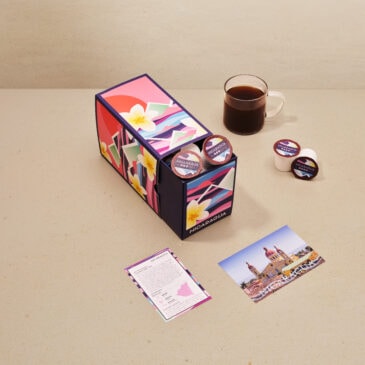A Keurig is a pod-brewing coffee machine made for those who value convenience over all else. If you need your first cup of coffee before you can face any measuring, grinding, or scooping, a Keurig coffee maker may be right up your alley.
In the spirit of convenience, you might hope to fill your reservoir and leave the same water in the tank until it runs out. If you use the water up within about 3-4 days, that’s fine. After that, you’ll want to replace it with fresh water.

"The best coffee pod I've ever tasted"
Yes, we mean that. Finally, specialty coffee for your KCup machine, roasted fresh to your order by our friends at Atlas Coffee in Austin, TX! Get 50% OFF to try it with code ROASTYPODS
Let’s take a closer look at how long you can leave water in a Keurig for the best taste results, hygiene, and cleanliness of your brewer.

Leaving Water In Your Keurig? Consider This.
Different Keurig coffee machines have different-sized water reservoirs. Depending upon the size of your tank and the amount of coffee you drink daily, you may find that the water empties quickly.
In this case, leaving water in your Keurig is fine. After all, that’s one of the main aims of this type of brewer!
If you don’t use your Keurig often or plan to place it in storage, it’s best not to leave water in the tank for more than a few days.
A 2011 study showed that coffee makers can be home to coliform bacteria, yeast, and mold. Since we know that’s not what you want lurking in your coffee, let’s explore when and how to refresh the water in your Keurig.
If Water is Left in a Keurig For Too Long…
Limescale
Letting water stagnate for a long time will lead to the development of limescale, which negatively alters the taste of the resulting coffee. In addition, if not addressed, it will lower the lifespan of your machine.
Bacteria
In extreme scenarios, harmful bacteria can thrive in your coffee equipment, leading to respiratory health problems and gastrointestinal symptoms like diarrhea and vomiting.
Internal Tank
Many Keurig machines have an internal tank in addition to the external reservoir. Even if you have poured the water out of your external tank, water can stagnate within the internal tank.
This can lead to mold and bacterial growth.
Below, we address ways to drain water from the internal tank.
I Left Water in My Keurig- What Do I Do?
If the water has only been standing for a couple of days, it’s likely still fine to use.
If you’re still worried, consider running a couple of brew cycles without a pod and throwing away the water that drips out. This will force any standing water out of the machine.
Draining the Internal Water Tank
If you’re planning to store your Keuring, it’s wise to ensure the internal water tank is empty. Unfortunately, Keurig’s official stance is that the internal tank can’t be emptied, and they don’t make it easy.
The reservoir is connected to an internal pump assembly through a draining pipe. Wherever you find this pipe, unplug it, and the water will drain out of the reservoir.
To get to this hose, you must first trace its location since different models have it in various places. After locating it, remove the screws on the side to access it.
It may be secured with a zip tie which you may need to cut before removing it from the fitting. Place the end of the pipe into a cup and let all the water drain. You will need patience since it requires several minutes to drain completely.
Once your reservoir has drained completely, secure the pipe with a cable tie and reassemble it again.
Please note: Keurig does NOT recommend doing this. If you choose to do so, be aware that you will probably invalidate your warranty and could damage your machine.
Descaling
Descaling removes mineral deposits that have accumulated on the inside of your coffee maker, especially when you are using hard water. Ideally, you should descale your Keurig every three to six months, depending on the frequency of use.
There are guidelines available from Keurig on how to descale each brewer. Ensure you use a Keurig-recommended descaling product, although a baking soda and vinegar solution also works well.
To run a descaling cycle, fill your reservoir with the descaling solution and run a couple of cleaning cycles to clean your coffee maker.
Run a Cleansing Cycle
If the process of opening a Keurig is a hassle for you, don’t worry. You can force out older water that might be hanging out in the tubes or internal tank.
You just need to run the machine without adding a K- Cup. You can do this a couple of times to ensure that the water in the machine’s inner workings is fresh.
If it’s been a few days since you last used your Keurig, the Keurig company recommends running a few cleansing brews before making your coffee.
Washing the Water Reservoir
It’s also very important that you clean the external water tank on a regular basis.
Remove the tank and wash it thoroughly with a lot of hot water and soap. In addition, you can also wash it with vinegar.
Fill the tank with the cleaning solution and let it stand for several minutes. Then, use a soft brush to gently scrub the inside of the tank and the water intake as you rinse with clean tap water.
For the models that come with a dishwater-friendly external tank, you only need to place it in your dishwater and run a cycle with your favorite commercial cleaning product.
You should also avoid touching the inside of your tank with your hands while refilling it, as this can transfer bacteria to the tank.
What do Manufacturers Recommend to Keep a Keurig Contaminant Free?
- Descale after 3-6 months
- Wash the reservoir every week
- Remove natural mineral buildup by washing with vinegar
- Run a cleansing brew to drive out standing water
- If your machine has not been in use for a long time, descale before use
Frequently Asked Questions
Can My Keurig Heat Water Enough to Kill Germs?
The internal temperature of a Keurig is 192 degrees, and the CDC reports that temperatures of 130-140 degrees can kill most bacteria.
So, the short answer is yes, but the CDC still recommends regularly cleaning and flushing any equipment that uses water.
Can I Leave a Keurig On All the Time?
No, Keurig recommends that you turn off your brewer after each use.
Wrap Up
A Keurig is a great brewer for anyone pressed for time in the morning that wants the most convenient possible route to their morning coffee. Understandably, coffee lovers needing speedy cups of coffee might not want to refill the reservoir every day.
It’s okay to keep water in your Keurig, but you shouldn’t leave it there for more than a few days, or you may experience problems with bacteria growth and limescale buildup.
As a best practice, empty your Keurig if you won’t be using it for a while, and run a few brewing cycles to force out any excess water before returning to your coffee brewing.
Happy Caffeinating!







